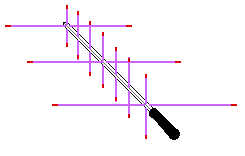
by Van Kichline, KD7QIT
I'm a happy owner of a Kenwood TH-D7AG HT, which I bought primarily because I was interested in APRS.
However, last field day Doug Bell (KD7KKR) and I spent several hours tracking and listening to amateur radio satellites with his HT and a 70 cm quad antenna. I was fascinated, so much so that I wound up doing a program on the history of amateur satellites at a PARS meeting a few months later. Later still, I decided to purchase an antenna and start talking over the satellites myself. The TH-D7AG is ideal for satellite communication, so I was half-set. Yes, 5 watts is plenty for most LEOs (Low Earth Orbit) satellites and several operate cross-band FM, with 2M up or down and 70 cm in the other direction.
A little research indicated that a great way to go would be the Arrow II:

It's a beauty! A three element, 2M Yagi combined with a 7 element 70 cm Yagi, and as light as a feather. That evening I was listening (but not talking) to passing satellites by locating them on Heavens Above and connecting one of my two antenna cables to my VR-120 communications receiver. I still needed a BNC to SMA adaptor to use the D7. I'd also missed the fact that Arrow offers a 10W duplexer which fits in the antenna's handle, so I ordered it, got the adaptors, and that weekend I was ready for my first QSO.
After learning how to get my D7 in full duplex mode, adding headphones and using PocketSat+ on my iPaq to locate the target, I managed to squeeze in a quick and clumsy contact with W7EEC using AO-51 Echo. I had joined the club! After the initial thrill had faded a little and I'd made a few more contacts, I began to realize a few things:
Holding even a light weight antenna up at arm's length for 15 minute passes is painful
Aiming an antenna manually isn't simple
Once you make contact, the fist thing that happens is that you get so excited that you loose the target
I decided that there had to be a better way to direct the antenna. I thought about tripods, telescope mounts, etc. Then, I had a lazier idea.
What causes the pain isn't the weight of the antenna, it's the balance. I thought that if I could hold the Arrow in the middle instead of at the end that I wouldn't have a problem. There's no way effective to handle the Arrow by grabbing it in the middle of the bristling elements, so I decided to add an extension onto the back end.
A trip to the hardware store without any preconceived notion of what to buy turned out unusually well. I picked up some PVC sprinkler risers which were threaded at both ends, some couplers, a cap, and a couple of short pieces of rebar which fit perfectly in the 1/2 PVC for balance. I also found a wonderful inclinometer, but no decent compass, to help me aim the device from the altitude and azimuth readout of PocketSat+. A little assembly, and viola:
I found a compass at the auto parts store with its own illuminator (my free time comes late at night when it comes at all.) The extension is mounted such that the handle can be easily unscrewed for transport. I wound up adding one of the rebar segments inside the end of the extension, and the balance was perfect! The Arrow's comfy rubber grip even fit nicely over the PVC riser.
I found some handy clip-on LED illuminators at the auto parts store so that I could light up the inclinometer. The "instrument panel" came together nicely:
I can set the movable stop on the inclinometer to the maximum altitude before the pass begins, then watch the compass and inclinometer and compare them to the readout on the PDA. The antenna is held in my right hand while my arm is dropped loosely to my side, the HT is in my left hand, headphones in place, and the PDA is usually on the bumper of a nearby car. It would be ideal to add the PDA to the instrument cluster; I'd like to try this but need a rock-solid holder. I'm really concerned about the PDA hitting the driveway, and for now the arrangement is convenient enough.
One lesson learned:
If you go to buy a ball compass (the best kind for this kind of application
because inclination can vary from 0 to 90 degrees in one pass) perform the "spin
test." Hold the compass in you hand and turn slowly around 360 degrees.
I find that one compass in a dozen will make the trip with you. I guess in
a vibrating automobile this isn't a problem, but on a hand-held device it
certainly is.
Lesson Two:
The inclinometer had two magnetic/rubber strips built in. It's best to
remove these to get accurate compass readings.
And how does it work? Fantastic! It takes a fraction of the energy it used to to locate and track a satellite. I get full quieting 75% of most passes. It's painless and quick to set up and use, too.
What's next? I got a Celestron NexStar 80GTL telescope for Christmas with a computerized tracking mount. The tracker can slew 4 degrees per second, and the detachable telescope tube is lighter than my extended antenna. This sounds like a natural combination, but I haven't found any pages on the web describing how to combine the two together yet. Watch this space!